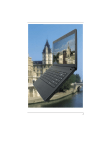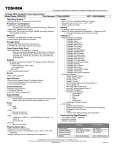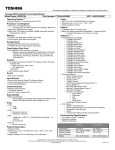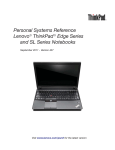Download DELL M900HD
Transcript
Dell™ Mobile Projector (M900HD) User’s Guide Notes, Cautions, and Warnings NOTE: A NOTE indicates important information that helps you make better use of your projector. CAUTION: A CAUTION indicates potential damage to hardware or loss of data if instructions are not followed. WARNING: A WARNING indicates a potential for property damage, personal injury, or death. ____________________ Information in this document is subject to change without notice. © 2013 Dell Inc. All rights reserved. Reproduction of these materials in any manner whatsoever without the written permission of Dell Inc. is strictly forbidden. Trademarks used in this text: Dell and the DELL logo are trademarks of Dell Inc.; DLP and DLP logo and DLP BrilliantColor are trademarks of TEXAS INSTRUMENTS INCORPORATED; Microsoft and Windows are either trademarks or registered trademarks of Microsoft Corporation in the United States and/or other countries. Wi-Fi® is a registered trademark of Wireless Ethernet Compatibility Alliance, Inc. Other trademarks and trade names may be used in this document to refer to either the entities claiming the marks and names or their products. Dell Inc. disclaims any proprietary interest in trademarks and trade names other than its own. Model : Dell Mobile Projector (M900HD) July 2013 Rev. A00 Contents 1 2 Your Dell Projector . . . . . . . . . . . . . . . . . . . . . . . 4 About Your Projector . . . . . . . . . . . . . . . . . . . . . . 5 Connecting Your Projector . . . . . . . . . . . . . . . . Connecting to a Computer . . . . . . . . . . . . . . . Connecting to Smartphone or Tablet Using Wi-Fi Connecting a DVD Player . . . . . . . . . . . . . . . . Connecting to Multimedia. . . . . . . . . . . . . . . . 3 Using Your Projector 7 . . 8 10 11 12 . . . . . . . . . . . . . . . . . . . . 14 Turning Your Projector On. . . . . . . . . . . . . . . . Turning Your Projector Off . . . . . . . . . . . . . . . Adjusting the Projected Image . . . . . . . . . . . . . Adjusting the Projector Focus . . . . . . . . . . . . . Adjusting Projection Image Size . . . . . . . . . . . . Using the Control Panel . . . . . . . . . . . . . . . . . Using the Remote Control. . . . . . . . . . . . . . . . Installing the Remote Control Battery . . . . . . . . Operating Range with Remote Control . . . . . . . Using the On-Screen Display . . . . . . . . . . . . . . Multimedia Introduction . . . . . . . . . . . . . . . . . Intel® Wireless Display (WiDi) Installation. . . . . . Wi-Fi Display Installation . . . . . . . . . . . . . . . . . Managing the Projector From Web Management Make Application Token . . . . . . . . . . . . . . . . . . . . . . . . . . 14 14 15 16 17 19 21 23 24 25 35 44 48 59 70 . . . . . . . . . . 71 Guiding Signals . . . . . . . . . . . . . . . . . . . . . . . . . 74 5 Specifications . . . . . . . . . . . . . . . . . . . . . . . . . . 75 6 Contacting Dell 7 Appendix: Glossary 4 Troubleshooting Your Projector . . . . . . . . . . . . . . . . . . . . . . . . . . . . . . . . . . . . . . . . . . . . . . . . . . . . . . . . . . . . . . . . . . . . . . . . . Contents 79 80 | 3 1 Your Dell Projector Your projector comes with all the items shown below. Ensure that you have all the items, and contact Dell™ if anything is missing. Package Contents Power cable 1.2 m USB cable (USB-A to USB-A) Remote control Carrying case CD User’s Guide and Documentation Sleeve cover Informacion Importante Dell™ Mobile Project or (M9 00HD) Documen tation Dell ™ Mobile Projector (M900HD) 0RV 7HWA0 0 gh ts re se r ve d. Contents: • User's Guide P/N RV7HW Rev. A00 P/N 36.8UJ01G001 July 2013 Made in China 4 01 ©2 3D e ll In c ll . A ri Your Dell Projector About Your Projector Bottom View Top View 7 9 1 62.3 20 6 2 3 5 4 55.00 55.00 8 1 Control panel 2 Focus ring 3 Lens 4 Elevator button for height adjustments 5 3 W speaker 6 IR receivers 7 Mounting holes for ceiling mount: Screw hole M3 x 6.5 mm depth. Recommended torque <15 kgf-cm 8 Mounting hole for tripod: Insert nut 1/4"*20 UNC 9 Elevator foot CAUTION: Safety Instructions 1 Do not use the projector near appliances that generate a lot of heat. 2 Do not use the projector in areas where there is an excessive amount of dust. The dust may cause the system to fail and the projector will automatically shut down. 3 Ensure that the projector is mounted in a well-ventilated area. 4 Do not block the ventilation slots and openings on the projector. 5 Ensure the projector operates between ambient temperatures (5 °C to 35 °C). Your Dell Projector 5 6 Do not try to touch the ventilation outlet as it can become very hot after the projector has been turned on or immediately after it is turned off. 7 Do not look into the lens while the projector is on as it may cause injury to your eyes. 8 Do not place any objects near or in front of the projector or cover its lens while the projector is on as the heat may cause the object to melt or burn. 9 Do not use alcohol to wipe the lens. 10 Do not use the wireless projector near cardiac pacemakers. 11 Do not use the wireless projector near medical equipment. 12 Do not use the wireless projector near microwave ovens. NOTE: •Do not attempt to ceiling mount the projector by yourself. It should be installed by a qualified technician. •Recommended Projector ceiling mount Kit (P/N: C3505). For more information, see the Dell Support website at dell.com/support. •For more information, see the Safety Information that shipped with your projector. •The M900HD projector can only be used indoors. 6 Your Dell Projector 2 1 Connecting Your Projector 2 3 4 5 6 1 2 Security cable slot Power cord connector 4 5 HDMI connector USB type A connector for USB display, multimedia playback (Video/Music/Photo/Office Viewer), USB memory storage access (USB flash drive/internal memory) and projector firmware upgrade 3 SD card slot for multimedia playback (Video/ Music/ Photo/ Office Viewer) 6 Audio-out connector CAUTION: Before you begin any of the procedures in this section, follow the Safety Instructions as described on page 5. Connecting Your Projector 7 Connecting to a Computer Connecting a Computer Using a USB Cable XELOM 2 1 MOLEX 1 2 Power cord USB-A to USB-A cable NOTE: Plug and Play. Only one USB (type A to A) cable is shipped with your projector. An additional USB (type A to A) cable can be purchased on the Dell website at www.dell.com. 8 Connecting Your Projector Connecting a Computer Using Intel® WiDi or Wi-Fi NOTE: Your computer should be equipped with a wireless connector and properly configured to detect another wireless connection. Refer to your computer’s documentation on how to configure a wireless connection. NOTE: To connect a computer via Intel® WiDi, your computer must be Intel® WiDi compatible. Connecting Your Projector 9 Connecting to Smartphone or Tablet Using Wi-Fi NOTE: Dell M900HD supports MobiShow and WiFi-Doc functions. They are applications which transmit supported content from your Android or iOS devices wirelessly. After installing and launching the application on your mobile device, enable Wi-Fi on your mobile device and connect to the projector network, Dell M900HD. For more Information, please visit go to Dell Support site at dell.com/support. Files supported are: MobiShow WiFi-Doc 10 Photo Format JPEG/JPG Document Format MS Word/Excel/PowerPoint/PDF/Text Connecting Your Projector PtG Format PtG2 Picture Format JPEG/JPG Connecting a DVD Player Connecting a DVD Player Using a HDMI Cable 2 1 TOP MENU HDMI MENU OPEN/CLOSE STANDBY/ON ENTER DVD/USB 1 2 USB HOME MENU RETURN Power cord HDMI cable NOTE: The HDMI cable is not shipped with your projector. You can purchase the HDMI cable on the Dell website at www.dell.com. Connecting Your Projector 11 Connecting to Multimedia Connecting Multimedia Using a USB Flash Disk 2 1 1 2 Power cord USB flash disk NOTE: The USB flash disk is not shipped with your projector. 12 Connecting Your Projector Connecting Multimedia Using a SD Card 2 1 1 2 Power cord SD card NOTE: The SD card is not shipped with your projector. Connecting Your Projector 13 3 Using Your Projector Turning Your Projector On NOTE: Turn on the projector before you turn on the source (computer, DVD player, etc.). The Power button light blinks white until pressed. 1 Connect the power cord and appropriate signal cables to the projector. For information about connecting the projector, see "Connecting Your Projector" on page 7. 2 Press the Power button (see "Using the Control Panel" on page 19 to locate the Power button). 3 Turn on your source (computer, DVD player, etc). 4 Connect your source to the projector using the appropriate cable. See "Connecting Your Projector" on page 7 for instructions to connect your source to the projector. 5 By default, the input source of the projector is set to Intel® WiDi. Change the input source of the projector if necessary. 6 If you have multiple sources connected to the projector, press the Source button on the remote control or control panel to select the desired source. See "Using the Control Panel" on page 19 and "Using the Remote Control" on page 21 to locate the Source button. Turning Your Projector Off CAUTION: Unplug the projector after properly shutting down as explained in the following procedure. 1 Press the Power button. Follow the instruction displayed on screen to properly turn off the projector. NOTE: The "Press Power Button to Turn off Projector" message will appear on the screen. The message disappears after 5 seconds or you can press the Menu button to clear it. 2 Press the Power button again. The cooling fans continue to operate for 120 seconds. 3 To power off the projector quickly, press the Power button and hold for 1 second while the projector’s cooling fans are still running. 14 Using Your Projector NOTE: Before you turn on the projector again, wait for 60 seconds to allow the internal temperature to stabilize. 4 Disconnect the power cord from the electrical outlet and the projector. Adjusting the Projected Image Raising the Projector Height 1 Press the Elevator button. 2 Raise the projector to the desired display angle, and then release the button to lock the elevator foot into position. Lowering the Projector Height 1 Press the Elevator button. 2 Lower the projector, and then release the button to lock the elevator foot into position. 1 2 1 Elevator button 2 Elevator foot (Angle of tilt: 0 to 9.6 degrees) Using Your Projector 15 Adjusting the Projector Focus CAUTION: To avoid damaging the projector, ensure that the elevator foot is fully retracted before moving the projector or placing the projector in its carrying case. 1 Rotate the focus ring until the image is clear. The projector focuses at distances ranging between 2.98 ft to 7.87 ft (91 cm to 240 cm). 1 1 Focus ring 16 Using Your Projector Adjusting Projection Image Size 80" (203.2 cm) 70" (177.8 cm) Projector to screen distance 60" (152.4 cm) 50" (127.0 cm) 40" (101.6 cm) 3.97' (1.21 m) 4.95' (1.51 m) 5.9' (1.8 m) 6.89' (2.1 m) 7.87' (2.4 m) 30" (76.2 cm) 2.98' (0.91 m) Using Your Projector 17 Screen size Desired Distance (m) <A> Diagonal (inch) <B> Top W (cm) x H (cm) From base to top of image (cm) <C> 0.91 30 65 x 41 43 1.21 40 86 x 54 57 1.51 50 108 x 67 71 1.8 60 129 x 80 84 2.1 70 150 x 94 98 2.4 80 171 x 107 113 * This graph is for user reference only. * Offset Ratio: 105±5% Height (Hd): 84 cm W B C " 60 al: n go Dia Di 18 Using Your Projector sta e: nc m 1.8 A H Using the Control Panel 1 2 3 9 8 4 7 5 6 1 TEMP LED If the TEMP amber indicator is on or blinking, one of the following problems could be occurring: • Internal temperature of the projector is too high For more information, see "Troubleshooting Your Projector" on page 71 and "Guiding Signals" on page 74. 2 Error LED Error LED is blinking amber, one of the RGB LED has failed. The projector will automatically shut down. 3 Up / Keystone adjustment Press to navigate through the On-Screen Display (OSD) Menu items. Press to adjust image distortion caused by tilting the projector (+/-40 degrees). 4 Right Press to navigate through the On-Screen Display (OSD) Menu items. 5 Power Turns the projector on or off. For more information, see "Turning Your Projector On" on page 14 and "Turning Your Projector Off" on page 14. Using Your Projector 19 6 Down / Keystone adjustment Press to navigate through the On-Screen Display (OSD) Menu items. Press to adjust image distortion caused by tilting the projector (+/-40 degrees). 7 Menu 8 Left Press to activate the OSD. Use the directional keys and the Menu button to navigate through the OSD. / Source Press to navigate through the On-Screen Display (OSD) Menu items. Press to toggle through Intel® WiDi, Wi-Fi, DoUSB, HDMI, USB, SD, and Internal Memory sources when multiple sources are connected to the projector. 9 20 Enter Press to confirm the selected item. Using Your Projector Using the Remote Control 1 13 2 3 14 4 5 15 6 7 16 8 9 17 10 11 18 12 1 Source Press to switch between Analog RGB, Composite, and HDMI source. 2 Video mode The projector has preset configurations that are optimized for displaying data (presentation slides) or video (movies, games, etc.). Press the Video Mode button to toggle between Presentation mode, Bright mode, Movie mode, sRGB, or Custom mode. Pressing the Video Mode button once will show the current display mode. Pressing the Video Mode button again will switch between modes. 3 Aspect ratio Press to change aspect ratio of a displayed image. 4 Blank screen Press to hide/unhide the image. Using Your Projector 21 5 Menu Press to activate the OSD. 6 Up Press to navigate through the On-Screen Display (OSD) Menu items. 7 Left Press to navigate through the On-Screen Display (OSD) Menu items. 8 Enter Press to confirm the selection. 9 Keystone adjustment Press to adjust image distortion caused by tilting the projector (+/-40 degrees). 10 Down Press to navigate through the On-Screen Display (OSD) Menu items. 11 Keystone adjustment Press to adjust image distortion caused by tilting the projector (+/-40 degrees). 12 Mute Press to mute or un-mute the projector speaker. 13 Power Turns the projector on and off. For more information, see "Turning Your Projector On" on page 14 and "Turning Your Projector Off" on page 14. 14 Play/Pause Press to play/pause media file. 15 Stop Press to stop playing media file. 16 Right Press to navigate through the On-Screen Display (OSD) Menu items. 17 Volume up Press to increase the volume. 18 Volume down Press to decrease the volume. 22 Using Your Projector Installing the Remote Control Battery 1 Remove the battery holder by holding down the side release firmly and pulling out the battery holder. LT O R 20 32 align the polarity correctly according to the marking in the battery holder. S 2 Insert a CR2025 coin cell battery and C 3V NOTE: When you use the remote control S LT R C O 20 32 for the first time, there is a plastic sheet between the battery and its contact. Remove the sheet before use. 3V Using Your Projector 25 20 LT R O C M S 3 Replace the battery holder. 3V 23 Operating Range with Remote Control Distance Angle Operating range Angle Distance ±20° 7 m/22.97 feet Angle Di sta nc e NOTE: Actual operating range may slightly differ from the diagram. Weak battery will also prevent the remote control from properly operating the projector. 24 Using Your Projector Using the On-Screen Display • The projector has a multi-language On-Screen Display (OSD) Menu that can be displayed with or without an input source. • Press the Menu button on the control panel or the remote control to enter the Main Menu. • To select an option, press the or buttons on your projector’s control panel or remote control. • Use the or buttons on the control panel or remote control to adjust the settings. • To exit the OSD, press the Menu button directly on the control panel or the remote control. INPUT SOURCE The Input Source menu allows you to select your projector's input source. INTEL® WIDI—Press to access the projector's Intel® WiDi Guide screen (the default). WI-FI—Press to access the projector's Wireless Guide screen. DOUSB—Allows you to display the computer/laptop screen to your projector via the USB cable. NOTE: If the DoUSB can not display, please see "Troubleshooting" on page 71. HDMI—Press to detect a HDMI signal. USB—Allows you to playback the photo, music, or video files from your USB flash disk. See "Multimedia Introduction" on page 35. SD—Allows you to playback the photo, music, or video files from your SD card. See "Multimedia Introduction" on page 35. INTERNAL MEMORY—Allows you to playback the photo, music, or video files from internal memory of the projector. See "Multimedia Introduction" on page 35. NOTE: STORAGE MODE—You may also connect USB cable in Internal Memory source to execute copy, delete, move and more instructions from your computer to projector internal memory and SD card. Using Your Projector 25 When you connect the projector and computer via USB cable, a USB Connected message will pop up and allow you to select DoUSB or Storage Mode. VIDEO MODE The Video Mode menu allows you to optimize the display image. The options are: Presentation, Bright, Movie, sRGB (provides more accurate color representation), and Custom (set your preferred settings) mode. VOLUME The Volume menu allows you adjust the volume setting of your projector. VOLUME—Press 26 to decrease the volume and Using Your Projector to increase the volume. ADVANCED SETTINGS The Advanced Settings menu allows you to change settings for Image, Display, Projector, Menu, Power, and Information. IMAGE SETTINGS—Select and press to activate image settings. The image settings menu provides the following options: BRIGHTNESS—Press image. CONTRAST—Press and and to adjust the brightness of the to adjust the display contrast. COLOR TEMPERATURE—Allows you to adjust the color temperature. The screen appears cooler at higher color temperatures and warmer at lower color temperatures. WHITE INTENSITY—Press intensity. and use and to display white NOTE: If you adjust the settings for Brightness, Contrast, Color Temperature, and White Intensity the projector automatically switches to Custom mode. Using Your Projector 27 DISPLAY SETTINGS—Select and press to activate display settings. The display settings menu provides the following options: ASPECT RATIO—Allows you to select the aspect ratio to adjust how the image appears. Options are: Origin, 16:10, and 4:3. • Origin — Select Origin to maintain the aspect ratio of the image projector according to the input source. • 16:10 — The input source scales to fit the width of the screen to project a 16:10 screen image. • 4:3 — The input source scales to fit the screen and projects a 4:3 image. ZOOM—Press and to zoom and view the image. ZOOM NAVIGATION—Press Navigation menu. Use screen. PROJECTOR SETTINGS—Select and press to activate the Zoom to navigate the projection to activate projector settings. The projector settings menu provides the following options: 28 Using Your Projector PROJECTOR MODE—Allows you to select the projector mode, depending upon how the projector is mounted. • Rear Projection-Desktop — The projector reverses the image so that you can project from behind a translucent screen. • Rear Projection-Ceiling Mount — The projector reverses and turns the image upside down. You can project from behind a translucent screen with a ceiling-mounted projection. • Front Projection-Desktop — This is the default option. • Front Projection-Ceiling Mount — The projector turns the image upside down for ceiling-mounted projection. AUTO KEYSTONE—Select On to automatically adjust image distortion caused by tilting the projector. TEST PATTERN—Test Pattern is used to test focus and resolution. You can enable or disable the Test Pattern by selecting Off, 1, or 2. You can also invoke the Test Pattern 1 by pressing and holding down and buttons on the control panel simultaneously for 2 seconds. You can also invoke the test pattern 2 by pressing and holding down and buttons on the control panel simultaneously for 2 seconds. Test Pattern 1: Test Pattern 2: Using Your Projector 29 FACTORY RESET—Select Confirm and press to reset all settings to its factory default. The below warning message appears: Reset items include both computer sources and Video source settings. MENU SETTINGS—Select and press to activate the menu settings. The menu settings consists of the following options: MENU POSITION—Allows you to change the position of the OSD menu on the screen. MENU TIMEOUT—Allows you to adjust the time for an OSD timeout. By default, the OSD disappears after 20 seconds of non-activity. MENU TRANSPARENCY—Select to change the transparency level of the OSD background. MENU LOCK—Select On to enable Menu Lock and hide the OSD menu. Select Off to disable the Menu Lock. If you want to disable the Menu Lock function and have the OSD disappear, press the Menu button on the control panel or remote control for 15 seconds, then disable the function. PASSWORD—When Password Protect is enabled, a Password Protect screen requesting you to enter a password will be displayed when the power plug is inserted into the electrical outlet and the power for the projector is first turned on. By default, this function is disabled. You can enable this feature by selecting Enable. If the password has been set before, key in the password first and select the function. This password 30 Using Your Projector security feature will be activated the next time you turn on the projector. If you enable this feature, you will be asked to enter the projector's password after you turn on the projector: 1 First time password input request: a Go to Menu Settings, press the password settings. and then select Password to Enable b Enabling the Password function will pop up a change screen. Key in a 4-digit number from the screen and press . c To confirm, enter the password again. d If the password verification is successful, you may resume with accessing the projector's functions and its utilities. 2 If you have entered an incorrect password, you will be given two more chances. After three invalid attempts, the projector will automatically turn off. NOTE: If you forget your password, contact DELL or a qualified service person. 3 To disable the password function, select the Disable option to close the function. Using Your Projector 31 4 To delete the password, select the Delete option. CHANGE PASSWORD—Key in the original password. Then, enter the new password and confirm the new password again. 32 Using Your Projector POWER SETTINGS—Select and press to activate power settings. The power settings menu provides the following options: POWER SAVING—By default, the projector is set to enter power saving mode after 120 minutes of no activity. A warning message appears on screen showing a 60 seconds countdown before switching to power saving mode. Press any button during the countdown period to stop the power-saving mode. You can also set a different delay period to enter power saving mode. The delay period is the time you want the projector to wait without an input signal. If an input signal is not detected during the delay period, the projector turns off. To turn on the projector, press the Power button. LED MODE—Allows you to select between Normal or ECO mode. Normal mode operates at full power level. ECO mode operates at a lower power level which may provide longer LED life, quieter operation, and dimmer luminance output on the screen. INFORMATION—The information menu displays the current M900HD projector settings. Using Your Projector 33 LANGUAGE Allows you to set the language for the OSD. Press and different languages and press to change the language. 34 Using Your Projector to select Multimedia Introduction Multimedia format supported: Photo Format Image Type (Ext Name) GIF PNG BMP JPEG/JPG Sub Type Encode Type Max Pixels Baseline YUV420 YUV422 YUV440 YUV444 progressive YUV420 YUV422 YUV440 YUV444 8000 x 8000 8000 x 8000 8000 x 8000 8000 x 8000 8000 x 8000 Video Format File Format Max. Resolution Motion JPEG AVI MPEG-4 MOV ASF MKV WMV 1920 x 1080, 30fps 1920 x 1080, 30fps 1920 x 1080, 30fps 1920 x 1080, 30fps 1920 x 1080, 30fps 1920 x 1080, 30fps 1920 x 1080, 30fps MAX Bit Rate (bps) 20Mbps 20Mbps 20Mbps 20Mbps 20Mbps 20Mbps 20Mbps Max. Display Audio Format 1080p, 60 Hz LPCM 1080p, 60 Hz MPEG-1 1080p, 60 Hz Layer 3 1080p, 60 Hz 1080p, 60 Hz 1080p, 60 Hz 1080p, 60 Hz WMA Music Format Music Type (Ext Name) Max. Sample Rate (KHz) Max. Bit Rate (Kbps) LPCM 48 KHz 320 Kbps MPEG-1 Layer 3 48 KHz 320 Kbps WMA 48 KHz 320 Kbps WAV 48 KHz 320 Kbps OGG 48 KHz 320 Kbps Using Your Projector 35 How to set-up File Type for Multimedia with USB NOTE: A USB flash disk must be plugged into the projector if you want to use the multimedia USB function. Follow these steps to playback the Photo, Video, or Music files on your projector: 1 Connect the power cable and turn on the projector by pressing the power button. 2 Plug in a USB flash disk to your projector. 36 Using Your Projector 3 Access the Input Source menu, select the USB option, and press the button. The USB Screen shown below appears: 4 Select the multimedia files: Photo, Video, Music, or Office Viewer, and then press the to start playing. Or select the Setup option to change multimedia settings. See "Multimedia Setup" on page 43. Using Your Projector 37 How to set-up File Type for Multimedia with SD Card NOTE: A SD card must be plugged into the projector if you want to use the multimedia SD function. Follow these steps to playback the Photo, Video, or Music files on your projector: 1 Connect the power cable and turn on the projector by pressing the power button. 2 Plug in a SD card to your projector. The image input source will be automatically switched to SD screen when you plug in a SD card. 38 Using Your Projector 3 Access the Input Source menu, select the SD option and press the button. The SD Screen shown below appears: 4 Select the multimedia files: Photo, Video, Music, or Office Viewer, and then press the to start playing. Or select the Setup option to change multimedia settings. See "Multimedia Setup" on page 43. Using Your Projector 39 How to set-up File Type for Multimedia with Internal Memory Follow these steps to playback the Photo, Video, or Music files on your projector: 1 Connect the power cable and turn on the projector by pressing the power button. 2 Access the Input Source menu, select the Internal Memory option and press the 40 button. Using Your Projector The Internal Memory Screen shown below appears: 3 Select the multimedia files: Photo, Video, Music, or Office Viewer, to start playing. Or select the Setup option to and then press the change multimedia settings. See "Multimedia Setup" on page 43. Using Your Projector 41 Office Viewer for the USB, SD, and Internal Memory The Office Viewer feature allows you to use MS Excel, MS Word, MS PowerPoint, and PDF files. Buttons Introduction Use the up, down, left, and right buttons for navigation and your projector's control panel or remote control to select. Button 42 Up Down Left No function No function Previous No Next page page function Using Your Projector Right button on Enter Menu Back to previous menu Multimedia SETUP for USB, SD Card, and Internal Memory The multimedia setup menu allows you to change settings for Photo, Video, and Music. NOTE: Multimedia setup menu and set are the same for the USB, SD card, and Internal Memory. SLIDESHOW DISPLAY INTERVAL—Press or to select slideshow display interval. The image will automatically switch to the next photo after the time out. Options are: 5 seconds, 10 seconds, 30 seconds, and 1 minute. SLIDESHOW REPEAT—Press or to select slideshow repeat as Repeat or No Repeat. MOVIE PLAY MODE—Press or to select movie play mode. Options are: Once, Loop one, Loop all, and Shuffle. MUSIC PLAY MODE—Press or to select movie play mode. Options are: Once, Loop one, Loop all, and Shuffle. Using Your Projector 43 Intel® Wireless Display (WiDi) Installation NOTE: Your computer must have the following Intel® Wireless Display system requirements: System Component Requirement Processor ONE of the following mobile processors: 3rd generation Intel® Core™ Processor: all mobile processors 3rd Generation Intel® Core™ i7 Processor: 640M; 660LM; 640LM; 620LM; 620M; 610E; 690UM; 680UM; 660UM; 640UM; 620UM; 660UE; 3610QM; 3770T; 3820QM; 3840QM; 2710QE; 2820QM; 2720QM; 2635QM; 2630QM; 2657M; 2649M; 2629M; 2620M; 2617M; 2540M; 2520M; 2510E; 2640LM; 2620LM; 2630UM; 2610UM; 2530UM; 2920XM 3rd Generation Intel® Core™ i5 Processors: 580M; 560M; 540M; 520M; 480M; 460M; 450M; 430M; 580UM; 560UM; 540UM; 520UM; 470UM; 430UM; 2540M; 2520M; 2410M; 2537M; 2430M; 2435M, 2450M; 2467M 3rd Generation Intel® Core™ i3 Processors: 390M; 380M; 370M; 350M; 330M; 330E; 3110M; 3120M; 3240; 3240T; 3217U; 3225; 3229Y; 3220; 3220T; 2310E; 2310M; 2312M; 2328M; 2330E; 2330M; 2340UE; 2348M; 2350M; 2357M; 2365M; 2367M; 2370M; 2377M Graphics Intel® HD Graphics Wireless ONE of the following: Intel® Centrino® Wireless-N 1000, 1030, 2200, or 2230 Intel® Centrino® Wireless-N 2200 for Desktop Intel® Centrino® Advanced-N 6200, 6205, 6230, or 6235 Intel® Centrino® Advanced-N 6205 for Desktop Intel® Centrino® Wireless-N + WiMAX 6150 Intel® Centrino® Advanced-N + WiMAX 6250 Intel® Centrino® Ultimate-N 6300 44 Using Your Projector System Component Requirement Software Intel® My Wi-Fi Technology (Intel® MWT) and Intel® Wireless Display must be pre-installed and enabled. Operating System Windows 7 (64-bit), Home Premium, Ultimate or Professional Windows 7 (32-bit), Home Premium, Ultimate, Professional or Basic Windows 8 32-bit and 64-bit editions For more information, see the Intel® WiDi website at www.intel.com/go/widi. Enable Intel® WiDi on the Projector 1 Connect the power cable and press the power button. Using Your Projector 45 2 Press the Menu button on your projector control panel or remote control. NOTE: Use , , and buttons to navigate and 3 Select the input source as Intel® WiDi. to select. The Intel® WiDi Guide Screen shown below appears: 4 Take note of the ADAPTER NAME and PIN CODE. You will need this information to log in later. 46 Using Your Projector Launch the Intel® WiDi on Your Computer 5 Type WiDi in your Windows search bar. If your computer has built-in Intel® WiDi, you will see the “Intel® WiDi” application in your search results. 6 Connect your computer to Dell M900HD. Login Login with the PIN Code provided in Step 4 of Intel® Wireless Display (WiDi) Installation, then click OK. Using Your Projector 47 Wi-Fi Display Installation NOTE: Your computer must have the following minimum system requirements: Operating System: • Windows Microsoft Windows XP Home or Professional Service pack 2 (32-bit recommended), Windows Vista 32-bit, and Windows 7 Home or Professional 32-bit or 64-bit, Windows 8 32-bit or 64-bit • MAC MacBook and above, MacOS 10.5~10.8 Minimum Hardware: a Intel Dual Core 1.8 MHz or higher b 256 MB of RAM required, 512 MB or more recommended c 10 MB of available hard-disk space d nViDIA or ATI graphic card with 64 MB VRAM or above e Ethernet adapter (10 / 100 bps) for an Ethernet connection f A supported WLAN adapter for a WLAN connection (any NDIS-compliant 802.11b or 802.11g or 802.11n Wi-Fi device) Web browser Microsoft Internet Explorer 6.0 or 7.0 (recommended) or 8.0, Firefox 2.0, Safari 3.0, and above 48 Using Your Projector Enable Wi-Fi on the Projector 1 Connect the power cable and press the power button. 2 Press the Menu button on your projector control panel or remote control. NOTE: Use 3 , , and buttons to navigate and Select the input source as Wi-Fi. to select. Using Your Projector 49 The Wireless Guide Screen shown below appears: 4 Take note of the Wireless Network (SSID), IP Address, and Access Code. You will need this information to log in later. 50 Using Your Projector Install the Dell Projector Connection Manager on Your Computer 5 Connect your computer to the M900HD wireless network. NOTE: • Your computer must have wireless network function to detect the connection. • When you connect to the M900HD wireless network, you will lose wireless connectivity with other wireless networks. NOTE: Remember to turn off all proxies. (In Microsoft® Windows Vista: Click Control Panel J Internet Options J Connections J LAN Settings) 6 Open your Internet browser. You will be automatically directed to the M900HD Web Management web page. Using Your Projector 51 NOTE: If the web page does not load automatically, enter the IP address (default IP address is 192.168.100.10) noted from the projector’s screen in the browser’s address bar. 7 The M900HD Web Management page opens. For first time use, click Download. 8 Select the appropriate operating system, then click Download. 52 Using Your Projector 9 Click Run to proceed with the one-time installation of the software. NOTE: You may choose to save the file and install it at a later time. To do this, click Save. NOTE: If you are unable to install the application because of inadequate rights on the computer, please contact your network administrator. 10 The installation software will launch. Follow the on-screen instructions to complete setup. Using Your Projector 53 Launch the Dell Projector Connection Manager Once the installation is complete, the program will launch and search automatically. If the program does not launch automatically, you can double-click the icon on the desktop to start the application. Select the Dell M900HD Wireless Mobile, and then click OK. Login Login with the Access Code provided in Step 4 of Wi-Fi Display Installation, then click OK. 54 Using Your Projector Understanding the Buttons After a successful log in, the following screen appears: Item 1 2 Description Status Bar Settings Click to activate the application settings. Minimize button Click to minimize the application. Close button Click to exit the application. Controls Toolbar Information Click to display SSID, IP, and Access Code information. Share mode Click to activate the share mode. Display mode Click to change the display mode. Pause Click to pause projection. Play Click to project the image in full screen. Sound Click to enable the sound. Using Your Projector 55 Using the Settings Click to display the settings menu. RESOLUTION—Allows you to setup the resolution. DISPLAY MODE—Allows you to setup the default projection mode. 56 Using Your Projector AUDIO—Allows you to change the audio settings. USB DONGLE—Allows you to create USB dongle. See "Make Application Token" on page 70. Using Your Projector 57 ABOUT—Displays the application version. 58 Using Your Projector Managing the Projector From Web Management Configuring the Network Setting If the projector is connected to a network, you can access the projector using a web browser. Accessing Web Management Use Internet Explorer 6.0 and above or Firefox 2.0 and above and enter the IP address. You can now access Web Management and manage the projector from a remote location. Home Page • Access the Web Management Home page by entering the projector’s IP address at the web browser (default IP address is 192.168.100.10). • Select the language for web management from the list. • Click any menu item on the left tab to access the page. Using Your Projector 59 Download the Dell Projector Connection Manager See also "Wi-Fi Display Installation" on page 48. Click the Download button of the corresponding operating system of your computer. 60 Using Your Projector Managing Properties Admin An administrator password is required to access the Admin page. • Admin Password: Enter the administrator password and then click Login. The default password is "admin". To change the password, see "Change Passwords" on page 66. Using Your Projector 61 System Status Displays the Network Status, Connection Status, and Projector Status information. 62 Using Your Projector Network Status IP Setup • Choose Obtain an IP address automatically to assign an IP address to the projector automatically, or Use the following IP address to assign an IP address manually. DHCP Server Setup • Choose Auto to automatically set up the Start IP, End IP, Subnet Mask, Default Gateway, and DNS Server address from a DHCP server, or Disable to disable this function. Using Your Projector 63 Wireless Setup • Choose Enable to set up the Region, SSID, SSID Broadcast, Frequency Band, Channel, Encryption, and Key. Choose Disable to disable the wireless set up. SSID: Up to maximum length of 32 characters. Encryption: You can Disable WPA key or select one of 64-bit or 128 bit in ASCII or HEX string. Key: If Encryption is enabled, you have to set key value according to the Encryption mode you selected. Click the Apply button to save and apply changes. The projector must be restarted for the changes to take effect. 64 Using Your Projector Projection Setup Projection Setup Login Code: Select how you want the login code to be generated by the projector. There are three options: • Disable: Login code will not be required when logging in to the system. • Random: Default is Random. Login code will be randomly generated. • Use the following code: Enter a 4-digit code. This code will be used to log in to the system. Click the Apply button to save and apply changes. The projector must be restarted for the changes to take effect. Using Your Projector 65 Change Passwords This page allows you to change the administrator password. • Enter New Password: Enter the new password. • Confirm New Password: Enter the password again and click Apply. NOTE: Contact Dell if you forget your administrator password. 66 Using Your Projector Reset to Default Click the Apply button to restore the wireless/network setup to its factory default settings. Using Your Projector 67 Firmware Upgrade Use the Firmware Upgrade page to update your projector’s Wi-Fi and Intel® WiDi firmware. To start firmware update, follow these steps: 1 You can download the firmware files from dell.com/support. 2 Press Browse to select the file to update. 3 Click the Update button to start. Wait while the system updates the firmware in your device. CAUTION: Do not interrupt the update process as this may cause the system to crash! 4 Click OK when the update is complete. 68 Using Your Projector Reboot System Click Reboot to reboot the system. Using Your Projector 69 Make Application Token The Application Token lets you perform Plug and Show using a USB token. 1 From the application software, click > USB Dongle. 2 The following screen appears. Click Next. 3 Plug a flash drive into any of the USB ports on your computer. Select the drive from the list, then click Next. 4 Click Finish to close the wizard. 70 Using Your Projector 4 Troubleshooting Your Projector If you experience problems with your projector, see the following troubleshooting tips. If the problem persists, contact Dell (see Contacting Dell™ on page 79). Problem Possible Solution No image appears on the screen • Ensure that the projector is turned on. • Ensure that you have chosen the correct input source on the INPUT SOURCE menu. • Ensure the external graphics port is enabled. If you are using a Dell laptop computer, press (Fn+F8). For other computers, see your respective documentation. If images are not displayed properly, please upgrade the video driver of your computer. For Dell computers, see support.dell.com. • Ensure that all the cables are securely connected. See "Connecting Your Projector" on page 7. • Ensure that the pins of the connectors are not bent or broken. • Use Test Pattern in the Projector Settings of the Advanced Settings menu. Ensure that the colors of the test pattern are correct. F8 CRT/LCD Fn Troubleshooting Your Projector 71 Problem (continued) Possible Solution (continued) Partial, scrolling, or If you are using a Dell™ portable incorrectly displayed image computer, set the resolution of the computer to WXGA (1280 x 800): a Right-click the unused portion of your Microsoft® Windows® desktop, click Properties, and then select Settings tab. b Verify that the setting is 1280 x 800 pixels for the external monitor port. c Press (Fn+F8). If you experience difficulty in changing resolutions, or if your monitor freezes, restart all the equipment and the projector. If you are not using a Dell™ portable computer, see your documentation. If images are not displayed properly, please upgrade the video driver of your computer. For a Dell computer, see dell.com/support. The screen does not display your presentation If you are using a portable computer, press (Fn+F8). Image is unstable or flickering Adjust the tracking in the OSD Display Settings of the Advanced Settings menu (in PC Mode only). Image has vertical flickering bar Adjust the frequency in the OSD Display Settings of the Advanced Settings menu (in PC Mode only). Image color is incorrect Use Test Pattern in the Projector Settings of the Advanced Settings menu. Ensure that the colors of the test pattern are correct. Image is out of focus 1 Adjust the focus ring on the projector lens. 2 Ensure that the projection screen is within the required distance from the projector (2.98 ft [91 cm] to 7.87 ft [240 cm]). 72 Troubleshooting Your Projector Problem (continued) Possible Solution (continued) Image is reversed Select Projector Settings of the Advanced Settings from the OSD and adjust the projector mode. Error LED is blinking amber A projector fan has failed and the projector will automatically shut down. TEMP LED is solid amber The projector has overheated. The display automatically shuts down. Turn the display on again after the projector cools down. If the problem persists, contact Dell. TEMP LED is blinking amber If the projector fan fails, the projector will automatically shut down. Clear the projector mode by pressing and holding the POWER button for 10 seconds. Please wait for about 5 minutes and try to power up again. If the problem persists, contact Dell. The OSD does not appear on the screen Press the Menu button on the panel for 15 seconds to unlock the OSD. Check the Menu Lock on page 30. The remote control is not operating smoothly or works only within a limited range The battery may be low. Check if the LED indication from the remote is too dim. If so, replace with a new CR2025 battery. DoUSB not displaying Display over USB Should run automatically. To manually run USB display, go to My Computer and run "USB_Display.exe". NOTE: You may require administrator level access to install the driver. Contact your network administrator for support. Troubleshooting Your Projector 73 Guiding Signals Control Buttons Projector Status Description Indicator Power (White/Amber) TEMP (Amber) (Amber) Standby mode Projector in Standby mode. Ready to power on. White Flashing OFF OFF LED on Projector in Normal mode, ready to display an image. White OFF OFF Cooling mode Projector is cooling to shutdown. White OFF OFF Projector overheated Air vents might be blocked or ambient temperature may be above 35 °C. The projector automatically shuts down. Ensure that the air vents are not blocked and that the ambient temperature is within operational range. If the problem persists, contact Dell. OFF AMBER OFF Fan breakdown One of the fans has failed. The projector automatically shuts down. If the problem persists, contact Dell. OFF AMBER Flashing OFF LED failure LED defective. OFF OFF AMBER R-LED driver over-heated Air vents might be blocked or the R LED driver has overheated. The projector will automatically shut down. Turn the display on again after the projector cools down. If the problem persists, contact Dell. AMBER AMBER OFF 74 Troubleshooting Your Projector 5 Specifications Light Valve 0.45" WXGA S450 DMD, DarkChip3™ Brightness 900 ANSI Lumens (Max.) Contrast Ratio Max: 10000:1 APM Native: 700:1 Typical (Full On/Full Off) Uniformity 85% Typical (Japan Standard - JBMA) Number of Pixels 1280 x 800 (WXGA) Aspect Ratio 16:10 Internal Flash 2 GB Memory (Max.) Displayable Color 1.07 billion colors Projection Lens Fixed Focal Lens, F/1.5 Throw ratio =1.4 wide and tele Offset ratio: 105% ± 5% Projection Screen Size 30~80 inches (diagonal) Projection Distance 2.98~7.87 ft (91 cm ~ 240 cm) Video Compatibility HDMI input: 1080p, 720p, 576i/p, 480i/p Power Supply Universal AC 100-240 V 50/60 Hz with PFC input Power Consumption Normal mode: 142 W ± 10% @ 110 Vac Eco mode: 106 W ± 10% @ 110 Vac Power saving mode: < 0.5 W (Fan speed at minimum) Standby mode: < 0.5 W Audio 1 speaker x 3 watt RMS Noise Level Full-on mode: Typical: 36 dB(A), Maximum: 38 dB(A) Eco mode: Typical: 34 dB(A), Maximum: 36 dB(A) Weight 3.5 lbs (1.59 Kg) Specifications 75 Dimensions (W x H x D) 9.13 x 1.69 x 6.46 inches (232 x 43 x 164 mm) 9.13 "(23 2 mm ) 1.69"(43 mm) " 46 m 6. 4 m 6 1 ( Environmental ) Operating temperature: 5 °C - 35 °C (41 °F- 95 °F) Humidity: 80% maximum Storage temperature: 0 °C to 60 °C (32 °F to 140 °F) Humidity: 90% maximum Shipping temperature: -20 °C to 60 °C (-4 °F to 140 °F) Humidity: 90% maximum I/O Connectors Power: One AC power socket (3-pin - C14 inlet) HDMI input: One HDMI connector for supporting HDMI 1.3. HDCP compliant. Audio output: One 3.5 mm stereo mini phone jack. USB (type A) port: One USB connector for supporting USB display, multimedia playback (Video/Music/Photo/Office Viewer), USB memory storage access (USB flash drive/internal memory), and projector firmware upgrade. The USB thumb drive can support up to 32 GB. SD card slot: One SD connector for supporting multimedia playback (Video/Music/Photo/Office Viewer). The SD card can support up to 32 GB. 76 Specifications Wireless Wireless Standard: IEEE 802.11a/b/g/n (2T2R) OS environment: Windows 8/7/Vista/XP/2000, MAC OS X Supports MobiShow and WiFi-Doc projection. Light Source Mercury-free LED (up to 20000 hours in Normal mode) NOTE: The LED life rating for any projector is a measure of brightness degradation only, and is not a specification for the time it takes a LED to fail and cease light output. LED life is defined as the time it takes for more than 50 percent of a LED sample population to have brightness decrease by approximately 50 percent of the rated lumens for the specified LED. The LED life rating is not guaranteed in any way. The actual operating life span of a projector LED will vary according to operating conditions and usage patterns. Usage of a projector in stressful conditions which may include dusty environments, under high temperatures, many hours per day, and abrupt powering-off will most likely result in a LED’s shortened operating life span or possible LED failure. Specifications 77 Compatibility Modes (Digital) Resolution Refresh Rate (Hz) Hsync Frequency (KHz) Pixel Clock (MHz) 640 x 350 640 x 480 720 x 480 p60 720 x 576 p50 720 x 400 640 x 480 640 x 480 800 x 600 800 x 600 800 x 600 1024 x 768 1280 x 720 p50 1280 x 720 p60 1920 x 1080 i50 1920 x 1080 i60 1280 x 720 1024 x 768 1280 x 800 1366 x 768 1360 x 768 1024 x 768 1440 x 900 1280 x 1024 1400 x 1050 1280 x 800 1280 x 1024 1440 x 900 1680 x 1050 1280 x 960 1920 x 1080 1024 x 768 70.087 59.940 59.940 50.000 70.087 75.000 85.008 60.317 75.000 85.061 60.004 50.000 60.000 50.000 60.000 59.855 75.029 59.810 59.790 60.015 84.997 59.887 60.020 59.978 84.880 75.025 74.984 59.954 85.002 60.000 119.989 31.469 31.469 31.469 31.250 31.469 37.500 43.269 37.879 46.875 53.674 48.363 37.500 45.000 28.125 33.750 44.772 60.023 49.702 47.712 47.712 68.677 55.935 63.981 65.317 71.554 79.976 70.635 65.290 85.938 67.500 97.551 25.175 25.175 27.000 27.000 28.322 31.500 36.000 40.000 49.500 56.250 65.000 74.250 74.250 74.250 74.250 74.500 78.750 83.500 85.500 85.500 94.500 106.500 108.000 121.750 122.500 135.000 136.750 146.250 148.500 148.500 115.500 NOTE: Support HDMI 1024x768@120 Hz DLP Link 3D, Frame sequential 78 Specifications 6 Contacting Dell For customers in the United States, call 800-WWW-DELL (800-999-3355). NOTE: If you do not have an active Internet connection, you can find contact information on your purchase invoice, packing slip, bill, or Dell product catalog. Dell™ provides several online and telephone-based support and service options. Availability varies by country and product, and some services may not be available in your area. To contact Dell for sales, technical support, or customer service issues: 1 Visit go to www.dell.com/contactDell. 2 Select your region on the interactive map. 3 Select a Segment for Contact. 4 Select the appropriate service or support link based on your need. Contacting Dell 79 Web Management 7 Appendix: Glossary ANSI Lumens — A standard for measuring the brightness. It is calculated by dividing a square meter image into nine equal rectangles, measuring the lux (or brightness) reading at the center of each rectangle, and averaging these nine points. Aspect Ratio — The most popular aspect ratio is 4:3 (4 by 3). Early television and computer video formats are in a 4:3 aspect ratio, which means that the width of the image is 4/3 times the height. Brightness — The amount of light emitted from a display or projection display or projection device. The brightness of projector is measured by ANSI lumens. Color Temperature — The color appearance of white light. Low color temperature implies warmer (more yellow/red) light while high color temperature implies a colder (more blue) light. The standard unit for color temperature is Kelvin (K). Compressed Resolution — If the input images are of higher resolution than the native resolution of the projector, the resulting image will be scaled to fit the native resolution of the projector. The nature of compression in a digital device means that some image content is lost. Contrast Ratio — Range of light and dark values in a picture, or the ratio between their maximum and minimum values. There are two methods used by the projection industry to measure the ratio: 1 Full On/Off — measures the ratio of the light output of an all white image (full on) and the light output of an all black (full off) image. 2 ANSI — measures a pattern of 16 alternating black and white rectangles. The average light output from the white rectangles is divided by the average light output of the black rectangles to determine the ANSI contrast ratio. Full On/Off contrast is always a larger number than ANSI contrast for the same projector. dB — decibel — A unit used to express relative difference in power or intensity, usually between two acoustic or electric signals, equal to ten times the common logarithm of the ratio of the two levels. Diagonal Screen — A method of measuring the size of a screen or a projected image. It measures from one corner to the opposite corner. A 9 80 Glossary FT high, 12 FT wide, screen has a diagonal of 15 FT. This document assumes that the diagonal dimensions are for the traditional 4:3 ratio of a computer image as per the example above. DLP® — Digital Light Processing™ — Reflective display technology developed by Texas Instruments, using small manipulated mirrors. Light passing through a color filter is sent to the DLP mirrors which arrange the RGB colors into a picture projected onto screen, also known as DMD. DMD — Digital Micro-Mirror Device — Each DMD consists of thousands of tilting, microscopic aluminum alloy mirrors mounted on a hidden yoke. Focal Length — The distance from the surface of a lens to its focal point. Frequency — It is the rate of repetition in cycles per seconds of electrical signals. Measured in Hz (Hertz). HDCP — High-Bandwidth Digital-Content Protection — A specification developed by Intel™ Corporation to protect digital entertainment across digital interface, such as DVI, HDMI. HDMI — High-Definition Multimedia Interface — HDMI carries both uncompressed high definition video along with digital audio and device control data in a single connector. Hz (Hertz) — Unit of frequency. Keystone Correction — Device that will correct an image of the distortion (usually a wide-top narrow-bottom effect) of a projected image caused by improper projector to screen angle. Maximum Distance — The distance from a screen the projector can be to cast an image that is usable (bright enough) in a fully darkened room. Maximum Image Size — The largest image a projector can throw in a darkened room. This is usually limited by focal range of the optics. Minimum Distance — The closest position that a projector can focus an image onto a screen. NTSC — National Television Standards Committee. North American standard for video and broadcasting, with a video format of 525 lines at 30 frames per second. PAL — Phase Alternating Line. A European broadcast standard for video and broadcasting, with a video format of 625 lines at 25 frames per second. Reverse Image — Feature that allows you to flip the image horizontally. When used in a normal forward projection environment text, graphics, etc. are backwards. Reverse image is used for rear projection. SVGA — Super Video Graphics Array — 800 x 600 pixels count. Glossary 81 SXGA — Super Extended Graphics Array, — 1280 x 1024 pixels count. UXGA — Ultra Extended Graphics Array — 1600 x 1200 pixels count. VGA — Video Graphics Array — 640 x 480 pixels count. XGA — Extended Video Graphics Array — 1024 x 768 pixels count. WXGA — Wide Extended Graphics Array — 1280 x 800 pixels count. Zoom Lens — Lens with a variable focal length that allows the operator to move the view in or out making the image smaller or larger. Zoom Lens Ratio — Is the ratio between the smallest and largest image a lens can project from a fixed distance. For example, a 1.4:1 zoom lens ratio means that a 10 foot image without zoom would be a 14 foot image with full zoom. 82 Glossary Index A D Adjusting the Projected Image 15 Adjusting the Projector Height 15 Dell contacting 79, 80 Adjusting the Projector Zoom and Focus 16 Focus ring 16 C Connecting the Projector Connecting with an HDMI Cable 11 HDMI cable 11 Power cord 8, 11, 12, 13 SD card 13 To Computer 8 USB flash disk 12 USB-A to USB-A cable 8 Connection Ports Audio-out connector 7 HDMI connector 7 Power cord connector 7 Security cable slot 7 Contact Dell 4, 73 Control Panel 19 M Main Unit 5 3 W speaker 5 Control panel 5 Elevator button for height adjustments 5 Elevator foot 5 Focus ring 5 IR receivers 5 Lens 5 Menu Position 30 Menu Settings 30 Menu Timeout 30 Menu Transparency 30 O On-Screen Display 25 Input Source 25 P Password 30 phone numbers 79 Power Saving 33 Index 83 Power Settings 33 T Powering On/Off the Projector Powering Off the Projector 14 Powering On the Projector 14 telephone numbers 79 Test Pattern 29 Troubleshooting 71 Contact Dell 71 R Remote Control 21 Reset, Factory 30 S Specifications Aspect Ratio 75 Audio 75 Brightness 75 Contrast Ratio 75 Dimensions 76 Displayable Color 75 Environmental 76 I/O Connectors 76 Internal Flash 75 Light Valve 75 Noise Level 75 Number of Pixels 75 Power Consumption 75 Power Supply 75 Projection Distance 75 Projection Lens 75 Projection Screen Size 75 Uniformity 75 Video Compatibility 75 Weight 76 support contacting Dell 79, 80 84 Index



































































































